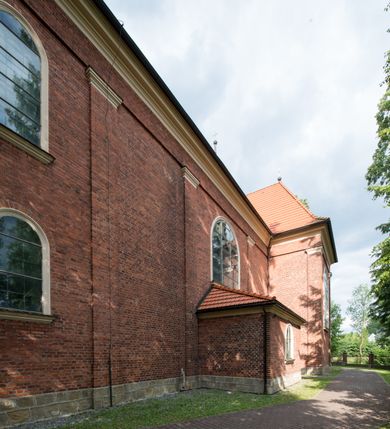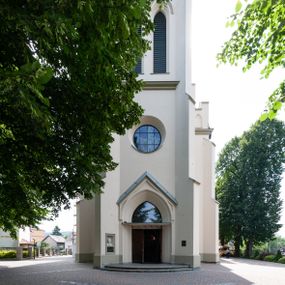
Holy Trinity Church in Krzywaczka
Place
Krzywaczka
Parish
Krzywaczka
Identifier
DZIELO/17424
Amount
1
Catalogue note author
Maria Działo
History of work
The first information about the appearance and furnishing of the church in Krzywaczka was recorded in the records of the episcopal visitation from 1598. It was a small, wooded building dedicated to the Holy Trinity, in which three altars were located at that time. From that time, an exceptionally valuable sculpture of Madonna and the Child has been preserved to this day. A similar, yet much shorter description of the church was included in the records of the visitation from 1616, and then from 1617 and 1644. It was only in the records of the visitation from 1703 that the invocation of the altar was mentioned. At that time the altars in the temple were: the altar of the Holy Trinity, the altar of the Blessed Virgin Mary, the altar of the Most Holy Name of Jesus and two altars in the chapel: the altars of St. Antony and St. Francis. At the time of the next visitation in 1729, the state of the altars remained unchanged. However, the painting of the Transfiguration of Jesus was noted in one of them. In the church inventory from 1891 the history of the construction of the second temple in Krzywaczka was described, which was erected in 1785 by the then heir and patron of the church, John of Nepomuk Korwin-Komecki. On 18 October 1788 the temple was consecrated by bishop of Tarnów Florian Amand Janowski. It was a wooden church with a ridge turret and a tower in the facade, covered with shingle, with an entrance through the main door of the church or through the sacristy. In the 1880s, the church and the sacristy were covered with a polychrome founded by the collator of the church and heir of the estate, Wincent Schmidt. The painting of the Transfiguration of Jesus and the figures of St. Peter and St. Paul the Apostle were placed in the high altar painted in white. The image of Jesus Crucified and the painting of the Sacred Heart of Jesus were located in the side altar. In the second side altar, there was a sculpture of Madonna and the Child from the 15th century. Both altars were painted in white, and made in 1866. Moreover, two confessionals painted in yellow and four unpainted confessionals made in 1887 were described in the inventory. There were also two patron's pews placed in the chancel and pews in the nave of the church. The inventory also includes organs founded by the previous collator, a stone baptismal font and numerous liturgical paraments.
The former temple in Krzywaczka was too small for the growing number of parishioners. On 27 June 1911 a foundation stone was laid and the construction of a new neo-Gothic church started, according to the design of Stefan Müller from Krakow, who created it in 1909. The building was erected in the place of the former church in 1911-1912 under the direction of Bartłomiej Kowalczyk from Podstolice. On 4 August 1912, the church was blessed, and in 1924 the temple was consecrated by bishop Anatol Nowak. In 1930, a portal in the facade was created, designed by Jan Hołuj from Myślenice. In the 1970s, the church interior was repainted white, thus the polychrome which had been created right after the church was built was covered. At that time, the historic pulpit was also dismantled. What happened to the paintings from the former temple remains unknown. Parish correspondence, currently stored in the Archives of the Metropolitan Curia provides information on only two paintings of Christ Crucified, which were to be donated to the National Museum in Krakow. Two side altars were moved from the former temple. The high altar of the church in Krzywaczka was created in the sculpture workshop of Władysław Druciak in 1914. The artist signed a contract with the then parish priest, Józef Nowak, in 1913. The painting of Madonna of Częstochowa on the sliding panel was created by painter Szczurowski, and works at the altar were finished by goldsmith, Józef Małek. The altar was created in the neo-Gothic style, reflecting medieval– gothic models and replicating old forms and ornaments, creating a new whole. The triaxial altar combines elements which are typical for Gothic architecture, such as openwork turrets crowned with pinnacles, fleuron ornaments and crockets, pointed arches, gables or traceries. Druciak's creative oeuvre is referred to as an example of historism in sacral sculpture from the beginning of the 20th century. The central niche of the altar in Krzywaczka houses a relief of the Holy Trinity, which is a direct reference to the invocation of the parish, whereas the smaller niches showcase the statues of St. Isidore, St. Ambrose and St. Dominic. The larger niches are devoted to the Polish patrons: St. Stanislaus and St. Adalbert, whereas the altar finial features a statue of Joseph with Infant Jesus. Placed in the side chapel, the neo-gothic altar was also created in the first quarter of the 20th century. A painting of St. Therese of Lisieux is placed in the central area. Apart from the main one, the temple boasts two other altars. One of them features an extremely valuable sculpture of the Madonna and the Child, which was created in the 1420s or 1430s. The statue was created in the region of Lesser Poland, which was proved in old literature and subsequently confirmed in contemporary references, where it was related to the sculpture from Jarząbka Nowa from ca. 1440, which was classified by Henryk Mędrek as an example of the so-called Pilsen type, as well as to the statue from Janowice. Information obtained during the monument's last conservation was used to restore the original appearance of the sculpture which has undergone multiple transformations throughout the ages, particularly in terms of form. Visiting the temple in Krzywaczka, make sure to marvel its Rococo procession ciborium which is one of few existing examples of this branch of artistic craft, which, made of perishable materials, failed to survive until the present day. The ciborium was created in the third quarter of the 18th century. The piece is a characteristic combination of abundantly sculpted, openwork frame decorated with Rocaille elements, with a material Intrados and suspended sides. The ciborium in Krzywaczka is additionally ornamented in the corners with four flaming vases which magnify the expression of the piece. Windows of the temple are decorated with bordure glazing created in 1912. According to the authors of "Corpus Vitrearum (...)" the same glazing was made in the church in Morawica by glazier Stanisław Wróblewski, which suggests his authorship of the stained glass in the local church.
Abstract
As the number of churchgoers began to outgrow the size of the old temple in Krzywaczka, the cornerstone for a new church was laid on June 27, 1911 and the construction of a new neo-gothic temple designed by Stefal Muller commenced. The new temple was built in the place of the old, wooden church. In 1924, the temple was consecrated by bishop Anatol Nowak. In the 1970s, the church interior was repainted white, thus covering the polychrome which had been created right after the church was built. The historical pulpit was also taken down. In 2006, the temple's leaking roof was replaced after 95 years, and documents related to the life of the parish were placed in one of the spheres crowning the roof. The high altar of the church in Krzywaczka was created in Władysław Druciak's sculpture workshop in 1914. The artist signed a contract with the then parish priest, Józef Nowak, in 1913. The Madonna of Częstochowa painting on the sliding panel was created by the painter Szczurowski, and altar works were finished by Józef Małek, a goldsmith. The altar was created in the Neo-Gothic style, reflecting medieval– gothic models and replicating old forms and ornaments, creating a new whole. The triaxial altar combines elements which are typical for Gothic architecture, such as openwork turrets crowned with pinnacles, fleuron ornaments and crockets, pointed arches, gables or traceries. Druciak's creative oeuvre is referred to as an example of historism in sacral sculpture from the beginning of the 20th century. The central niche of the altar in Krzywaczka houses a relief of the Holy Trinity, which is a direct reference to the invocation of the parish, whereas the smaller niches showcase the statues of St. Isidore, St. Ambrose and St. Dominic. The larger niches are devoted to the Polish patrons: St. Stanislaus and St. Adalbert, whereas the altar finial features a statue of Joseph with Infant Jesus. Placed in the side chapel, the neo-gothic altar was also created in the first quarter of the 20th century. A painting of St. Therese of Lisieux is placed in the central area. Apart from the main one, the temple boasts two other altars. One of them features an extremely valuable sculpture of the Madonna and the Child, which was created in the 1420s or 1430s. The statue was created in the region of Lesser Poland, which was proved in old literature and subsequently confirmed in contemporary references, where it was related to the sculpture from Jarząbka Nowa from ca. 1440, which was classified by Henryk Mędrek as an example of the so-called Pilsen type, as well as to the statue from Janowice. Information obtained during the monument's last conservation was used to restore the original appearance of the sculpture which has undergone multiple transformations throughout the ages, particularly in terms of form. Visiting the temple in Krzywaczka, make sure to marvel its Rococo procession ciborium which is one of few existing examples of this branch of artistic craft, which, made of perishable materials, failed to survive until the present day. The ciborium was created in the third quarter of the 18th century. The piece is a characteristic combination of abundantly sculpted, openwork frame decorated with Rocaille elements, with a material Intrados and suspended sides. The ciborium in Krzywaczka is additionally ornamented in the corners with four flaming vases which magnify the expression of the piece.
Other works from this place
Other works from this year
Similar works
By title
By category

A front left wing of the old triptych of Our Lady of the Immaculate Conception

A plaque commemorating the victims of extermination

Adoration of the Holy Name of Jesus

Adoration of painting "Misericordia Domini" by the Polish saints

Adoration of the Holy Trinity by the all saints

Adoring angels
How to cite?
Maria Działo, "Holy Trinity Church in Krzywaczka", [in:] "The Sacred Lesser Poland Heritage", 2026, source: https://sdm.upjp2.edu.pl/en/works/holy-trinity-church-in-krzywaczka















































